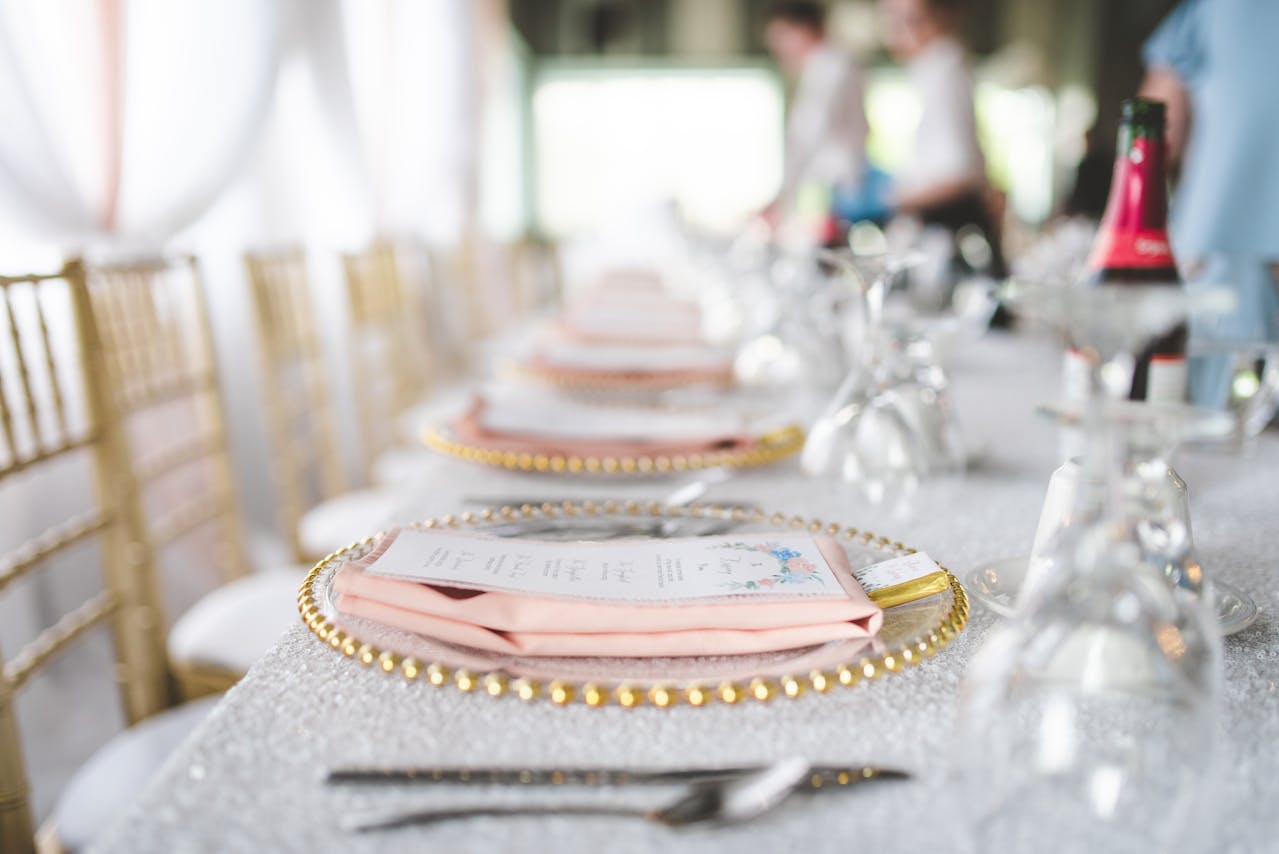
By Jermaine Thomas May 8, 2025
Wedding planning is a complex fusion of logistics, traditions, guest experience, and personal style. The cuisine is often one of the most talked-about aspects of a memorable celebration, out of all the many little details that go into it. A well-thought-out wedding menu can turn the occasion from a get-together into an unforgettable experience. Making each guest feel valued and included is just as important as providing mouthwatering food. It takes more than just choosing favorite dishes to create a menu that is both inviting and well-balanced.
Couples nowadays are more concerned with cultural diversity, dietary inclusivity, and artistic presentation. Whether you’re throwing a large ballroom event or a small backyard party, your menu should represent your values, impress your guests, and satisfy a range of dietary requirements.
The Growing Importance of Dietary Inclusivity
Modern weddings are more diverse than ever. Guests come from different cultures, lifestyles, and dietary backgrounds. This diversity presents an opportunity to create a menu that is thoughtful and inclusive. Couples today are increasingly aware of food sensitivities, ethical preferences, and religious dietary laws. Accommodating these considerations is no longer seen as a luxury but as a reflection of hospitality and respect. Dietary inclusivity ensures that no one feels left out during such an important celebration.
Understanding Your Guest List
Spend some time determining who will be attending before deciding on your menu. Make sure your digital invitations or RSVP cards have a space for guests to indicate any dietary needs or preferences. This easy step assists in determining whether you require halal meat, gluten-free foods, nut-free options, or other accommodations. Knowing your guests’ general dietary requirements will help you and your caterer make sure that nobody is left with too few or inappropriate options. Creating a menu that is cohesive and offers at least one or two options for each course is the aim.
Inclusive Doesn’t Mean Bland
There is a common misconception that inclusive menus must sacrifice flavor or presentation. On the contrary, inclusive dishes can be rich, colorful, and gourmet. Whether it’s a nut-free pesto pasta, a dairy-free dessert, or a vegan entrée, modern culinary techniques make it possible to delight all taste buds while meeting various dietary needs. Wedding menu ideas that emphasize variety and flexibility naturally lend themselves to inclusivity. Offering multiple choices for each course allows guests to find something they can enjoy without feeling like an afterthought.

Designing a Well-Balanced Menu
Creating a wedding menu that appeals to a large group of people requires careful thought. It should offer balance in flavor, texture, temperature, and style. You want your menu to be memorable but not too exotic, satisfying but not too heavy.
Starting with the Appetizers
Appetizers give guests something to look forward to and set the mood for the meal. Variety is added by providing a selection of both hot and cold appetizers, particularly for guests who might have particular requirements. For example, skewers with grilled chicken or tofu could be one dish, and a seasonal vegetable tart could be another. In order to accommodate guests with common intolerances, make sure that a few of the appetizers are naturally gluten and dairy free. The attractiveness and inclusivity of the menu can also be improved by adding one or two vegan wedding options.
Creative Main Course Ideas
When it comes to the main course, variety and flexibility are essential. A dual entrée option allows guests to enjoy a little bit of everything. Popular pairings include chicken and fish, beef and vegetables, or pasta and seafood. Plant-based dishes have become increasingly popular, even among non-vegan guests. A hearty mushroom risotto, a roasted vegetable lasagna, or a lentil-based shepherd’s pie can hold their own on a formal menu. Including thoughtful vegan wedding options does not just cater to specific guests but also adds creativity to the meal.
Satisfying Desserts for All
Dessert is often the grand finale of the meal. Offering more than just a traditional wedding cake adds excitement and accommodates dietary needs. Consider offering a trio of mini-desserts such as fruit compote, flourless chocolate cake, and coconut-based ice cream. If you are offering a dessert table or buffet, label everything clearly so guests know which items are nut-free, dairy-free, or vegan. This transparency helps everyone make safe and enjoyable choices.
Spotlight on Vegan Wedding Options

Vegan wedding options are no longer just an afterthought. With growing awareness around plant-based eating, many couples are choosing to feature vegan or vegetarian dishes front and center. These meals are now crafted with the same level of sophistication and creativity as any traditional option.
Elevating Plant-Based Cuisine
Vegan cuisine today is much more than just salads. In order to compete with meat-based dishes, chefs are experimenting with flavors and textures. Consider dishes like cauliflower steak with chimichurri sauce, cashew cheese and eggplant roulade, or jackfruit tacos with mango slaw. These dishes often spark conversation at the table because they are filling and visually appealing. Providing these choices also demonstrates your consideration for visitors who have ethical or environmental concerns. Options for vegan weddings show a progressive attitude and often reflect the sustainability and health values of the couple.
Making Vegan the Star
If you are planning a fully vegan wedding, communicate that clearly and confidently in your invitations or website. Guests are often more accepting when they are informed ahead of time and when the dishes are flavorful and well-prepared. You can also complement your menu with plant-based cocktails, dairy-free cakes, and vegan wine. Partnering with caterers who specialize in vegan cuisine ensures that every course feels curated and satisfying.
Cultural Influences and Fusion Cuisine
For many couples, honoring cultural traditions is a vital part of the wedding menu. Whether it is a family heritage dish or a favorite childhood comfort food, adding cultural elements to your menu adds depth and meaning.
Honoring Tradition
Including traditional dishes from your cultural background not only pleases older family members but introduces other guests to new flavors. This can be done without compromising dietary inclusivity. For example, a traditional Indian lentil curry can easily be made vegan and gluten-free without altering its essence. You can also serve heritage-inspired hors d’oeuvres or add a signature cultural dessert. The key is blending authenticity with accessibility, ensuring that every guest can enjoy the experience.
Fusion as a Creative Touch
Another interesting way to provide variety is through fusion cuisine. It enables you to combine components from several culinary traditions into a single, well-designed menu. Think of Mediterranean-style grain bowls, kimchi mac and cheese, or sushi tacos. Fusion cuisine appeals to diners from a variety of backgrounds and offers something familiar with a twist. Collaborate with chefs who are familiar with both flavor profiles when employing fusion techniques. This guarantees that the dish keeps its integrity while providing a unique and enjoyable experience.
Beverage Pairings and Non-Alcoholic Options
No menu is complete without the right beverages. Offering thoughtful drink pairings shows attention to detail and enhances the dining experience. From wine selections to craft mocktails, there are many ways to elevate the drink menu.
Matching Drinks to Courses
Pairing wine with each course is a classic choice. But modern weddings are also experimenting with beer pairings, signature cocktails, or curated tea selections. These pairings can mirror the menu theme or reflect the couple’s personality. For instance, a citrusy cocktail may go well with light seafood, while a spiced wine might complement a hearty plant-based entrée.
Non-Alcoholic Options with Flair
Offering elegant non-alcoholic options is crucial because not all guests consume alcohol. Consider alternatives to soda and lemonade. Think about fruit infusions, herbal spritzers, or alcohol-free wines. To demonstrate equal importance, clearly label these and serve them at the bar with other drinks. These minor details help create a friendly environment for all.

Practical Tips for Seamless Execution
Crafting the perfect menu is just one part of the process. Ensuring it is delivered successfully involves coordination, communication, and attention to detail.
Work Closely with Your Caterer
Select a caterer who can modify dishes without sacrificing flavor and has experience with dietary inclusivity. Ask for tastings or sample menus and be explicit about your expectations. Give them advance notice of the guests’ dietary requirements so they can make the necessary arrangements. If you have guests with severe allergies, you should also let the caterers know about the dangers of cross-contamination. Mix-ups can be avoided with clear labeling and kitchen procedures.
Use Menu Cards and Clear Signage
Guests appreciate knowing what they are eating. Menu cards at each place setting or signs at a buffet are useful for describing each dish. Indicate if items are vegan, gluten-free, nut-free, or contain allergens. This reduces uncertainty and ensures guests can enjoy their meal confidently.
Plan for Extra Portions
It is always wise to prepare extra portions of inclusive dishes, especially if they are particularly appealing. Many guests will gravitate toward lighter, plant-based options regardless of their dietary habits. Having a few additional servings on hand prevents shortages and keeps the dining experience smooth for everyone.
Conclusion
A wedding is an occasion to celebrate love, bonding, and happiness. A menu that makes each visitor feel valued is one of the greatest ways to convey these values. Every dish, from inventive appetisers to mouthwatering desserts, adds to the mood and creates enduring memories of the day. Couples can design a menu that is delectable, considerate, and unforgettable by embracing dietary inclusivity, trying vegan wedding options, and taking inspiration from various culinary traditions.
The goal of today’s wedding menu ideas is to make guests feel seen and welcomed, not just to stuff plates. Heartfelt compliments, delighted guests, and a wedding day where no one is left behind are the results of making the effort to take into account everyone’s needs.